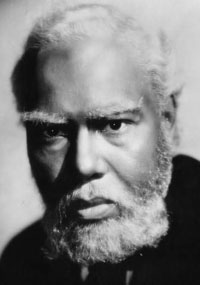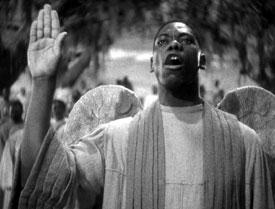 The dvd for The Green Pastures (1936) included the contemporary trailer which features Dick Powell delivering a lecture on the importance of the Pulitzer Prize play upon which the film is based, & promising it will be "An experience that will stay with you the rest of your life." Author & co-director Marc Connelly is shown overseeing the set design.
The dvd for The Green Pastures (1936) included the contemporary trailer which features Dick Powell delivering a lecture on the importance of the Pulitzer Prize play upon which the film is based, & promising it will be "An experience that will stay with you the rest of your life." Author & co-director Marc Connelly is shown overseeing the set design.
These white faces were important for advertising a film with an all black cast, in order to convince the larger white audience they should go see it too. And as point of fact Powell was not exaggerating about this being an unforgettable film.
I must've been seven or eight years old the first time I saw it, & I was mesmerized. I was too little to have any clear understanding of race in America, & when I saw children in heaven, & one of them riding a little cottony cloud like it's a hobby-horse, I wasn't thinking "What cute little pickaninnies" or "Oh those sweet superstitious darkies, ain't it just so dear that they believe stuff like that." I thought only "Wow! Kids can ride clouds in heaven!" In that case, Heaven was for me!
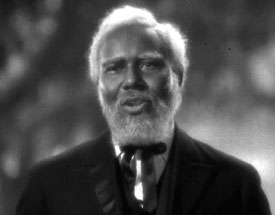 And I was too small to think it odd that God was a black man. I accepted the image of De Lawd as played by Rex Ingram as just what it was, a figure of grandfatherly beauty & dignity just a tad bit cantankerous who could manifest great power & who had enough love in him to hear even me if I was to pray to him, not a whole lot different from my very own grampa. Even the flowers spoke with adoration to De Lawd, & it made more sense to me than ever did the Easter Bunny or Santa Claus. And I was too small to think it odd that God was a black man. I accepted the image of De Lawd as played by Rex Ingram as just what it was, a figure of grandfatherly beauty & dignity just a tad bit cantankerous who could manifest great power & who had enough love in him to hear even me if I was to pray to him, not a whole lot different from my very own grampa. Even the flowers spoke with adoration to De Lawd, & it made more sense to me than ever did the Easter Bunny or Santa Claus.
Connelly's popular play upon which the film was based was in turn based on bits of Roark H. Bradford's Ol' Man Adam & His Chillun: Begin the Tales They Tell about the Time When the Lord Walked the Earth like a Natural Man (1928).
Bradford's rustic take on biblical tales was in turn based on authentic rural black folklore. So there is some lingering bit of African American authenticity at every level of revision, even if, after multiple layers of interpretation, the film is undeniably a white romance of "gospel darkies" & can be deconstructed at every turn for racist context, however well meaning Bradford then Connelly may have been.
But it's not essential to highlight the race politics, & I don't believe it is insensitive that the majority of viewers over the decades have refused to do so (I do think it cloddish when some reactionary insists it isn't even appropriate to consider such stereotypes as racist, & surprised how often that's expressed).
Both black & white audiences have loved this film, even though from the start (before Civil Rights consciousness was widespread) there were some black intellectuals & a few African American Christians generally who felt the childlike naivete of adult characters was patronizing & offensive to black people & irreverent to God.
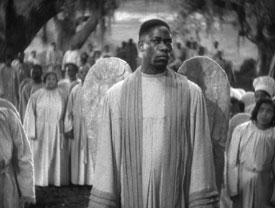 White christians wholeheartedly delighted in such stereotypes; & since they weren't stereotypes of hate, whites were less likely to question whether any of it might offend some people. White christians wholeheartedly delighted in such stereotypes; & since they weren't stereotypes of hate, whites were less likely to question whether any of it might offend some people.
But so too could the black-written, black-directed The Blood of Jesus (1941) be deconstructed in exactly the same manner. It was a great success in its day, aimed exclusively at eager black audiences, who didn't mind that it had every race-politic fault that the white-written white-directed film possessed. And to me both films were enjoyable fantasies with cultural & artistic factors that vastly outweigh the faults.
Since The Green Pastures has a prologue that establishes the biblical stories are being told to children, the whole issue of adult folk stereotyped as childlike is less on the mark than it might otherwise have been. And looked at as folklore, both Blood of Jesus & Green Pastures are pure delights. The flaws are more with society & are not inherent to the folklore. Indeed the folk tales could remain unchanged & verbatim, & would have an entirely different effect within an egalitarian society which would not assume naievete had something to do with race.
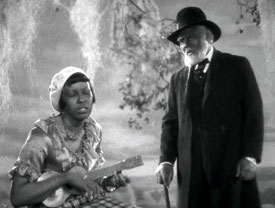 I'm not personally religious but in our society that kind of wants people to envision God as a big white-bearded white man (Zeus in essence), whenever I think of pop-images of God, I first see De Lawd from Green Pastures. It was very likely the first time I ever saw a portrait of God walking & talking & doing miracles & it would "stick" as a potent image of a Heavenly Father.
I'm not personally religious but in our society that kind of wants people to envision God as a big white-bearded white man (Zeus in essence), whenever I think of pop-images of God, I first see De Lawd from Green Pastures. It was very likely the first time I ever saw a portrait of God walking & talking & doing miracles & it would "stick" as a potent image of a Heavenly Father.
We are introduced to Heaven during the angels' fish-fry. Now the picnicky fish-fry was an African American institution from way back, but it looked no different to my child eyes than any working class picnic, save only that the people have wings. It was familiar, & it seemed right. If angels & childlike cheribim dwelt in heaven, then of course life would be like a perpetual fish-fry at which a good time is had by all.
It's a place where gentlemen angels smoke expensive cigars & angel ladies prepare the feast & mind the cherubim. When a child with tiny wings won't come down from cloud-riding, an angel-mommy warns, "You want me to fly up there & slap you down?" This, too, was totally familiar.
de Lawd comes & leads a call & response, "Has you been baptized?" "Certainly Lawd!" "Has you been baptized?" "Certainly Lawd!" "Has you been redeemed?" "Certainly Lawd!' "Has you been redeemed?" "Certainly Lawd! Certainly Lawd! Certainly Lawd!" And everyone sings "So High!" to Him. And it is during this fish-fry that God brings about all of Creation, while angels sing "In My Mansion Above."
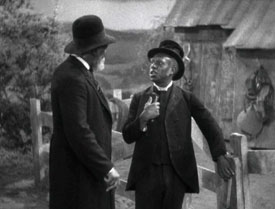 And I can still connect with my child-mind upon first seeing this great film, when I was young enough to see that Howdy Doody had strings attached to him but still thought he was alive & talking, & young enough to know I was watching a fantasy film but finding nothing at all unbelievable about it. And I can still connect with my child-mind upon first seeing this great film, when I was young enough to see that Howdy Doody had strings attached to him but still thought he was alive & talking, & young enough to know I was watching a fantasy film but finding nothing at all unbelievable about it.
A few years later I happened to see Richard Pryor impersonating God, doing sewing motions with is hands as he made Adam in the manner of a rag-doll, & singing to Himself, "Gimme that old time religion." Everyone laughed because it was funny, but to me it was a poem, it was true, it was Richard Pryor most correctly as De Lawd.
Our next important sequence in The Green Pastures is of Adam & Eve (Myrtle Anderson) in the Garden, warned to stay away from the Eden tree & failing to do so. And then upon the death of Abel (Duke Upshaw) at the hands of his brother (Al Stokes), De Lawd says with disappointment on his brow, "I don't like the way things are goin' a-tall."
De Lawd's next journey to the world finds him momentarily pleased by the beauty of flowers. "How's you little flowers doin'?" "We's okay Lawd" the flowers reply -- another moment that was burnt into my child-memory forever.
Alas, He must walk through a sinful world not so pleasing as the flowers. He encounters a rude girl who plays jazz on Sunday on her ukelele. She sasses De Lawd. Her name's Zeba (Edna Mae Harris), great-great granddaughter of Seth. Cane VI (James Fuller) is her boyfriend.
The town is a nightmare. Jazz, drinking, gambling, all on the Sabbath, De Lawd sees it everywhere. Cane VI & Flatfoot (Charles Andrews) fight over Zeba, and Flatfoot's knifed to death.
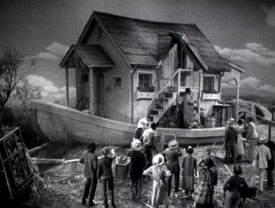 Obviously this world is unsalvagable & it's time to wipe the slate clean. But De Lawd would regret the loss of one good man, Noah (Eddie "Rochester" Anderson). Some amusing but in its entertaining way profound stuff leads us to the wonderful set design for the Ark, where among the cameos we catch a glimpse of Etta McDaniel (sister of Oscar winner Hattie McDaniel) giving Noah a hard time. Obviously this world is unsalvagable & it's time to wipe the slate clean. But De Lawd would regret the loss of one good man, Noah (Eddie "Rochester" Anderson). Some amusing but in its entertaining way profound stuff leads us to the wonderful set design for the Ark, where among the cameos we catch a glimpse of Etta McDaniel (sister of Oscar winner Hattie McDaniel) giving Noah a hard time.
Eventually we come to the time of Moses (Frank H. Wilson) & the liberation of the slaves to the tune of "Let My People Go" & the journey to Canaan to "Oh Glory Halleluja." And Joshua (Reginald Fenderson) at the fall of Jericho to "The Walls Come a-Tumblin' Down" as De Lawd leads Moses into Hebbin.
Ingrim plays other roles in the film besides De Lawd. He's Adam, made in De Lawd's image after all. And he's Hezdrel defender of Jerusalem, who teaches De Lawd something about mercy. And by Hezdrel's goodness De Lawd begins to forgive the world its sins.
The fall of Jerusalem is depicted in terms of modern warfare, & such destruction over the world is this time due to the actions of Man, not De Lawd's. We probably deserve De Lawd's wrath as much as ever, but in this fable of Divinity, God is capable of changing & maturing, & behaviors that once would've caused him to stomp us flat & wash us away with mop water, now makes him torn & sorrowful.
Ingram brought such credibility to the idea of a benevolent human god, who comes to doubt his own wisdom, who learns truly to love his children, even the ones who behave badly.
There's just so much fine acting in the story. Superb character actor Oscar Polk as Gabriel seems at times to help in the education of God. while I'm sure there are many believers who would find it mightily sacreligious that God ever had anything to learn from angels or from humanity, others must know that we are "in his image" faults & all.
If mortals are a reflection of a divine realm, there's no reason to doubt that On Earth As In Heaven there are things to learn, fish-fries to attend, battles to be won both within ourselves & in the larger world & the world beyond.
And the issue of naivete is not one of assumptions about race but about every human being's capacity to believe first in the supernatural, whether it's the Tooth Fairy or God, with even the rationalist understanding that We have created God in our own image -- an image that has much more to do with our history & actions than with our varied skin tones.
This is one of the world's great films. whether it merely makes you smile over its sweetness or makes you think deeply of the race politics the wider societal context imposes on it, it remains a great film.
copyright © by Paghat the Ratgirl
|
